If you’re looking for a recipe for pesto using fresh basil, then you’re in luck! In this post, I will share my easy recipe (without nuts or cheese), and show you exactly how to make basil pesto with fresh leaves from your garden or the store.
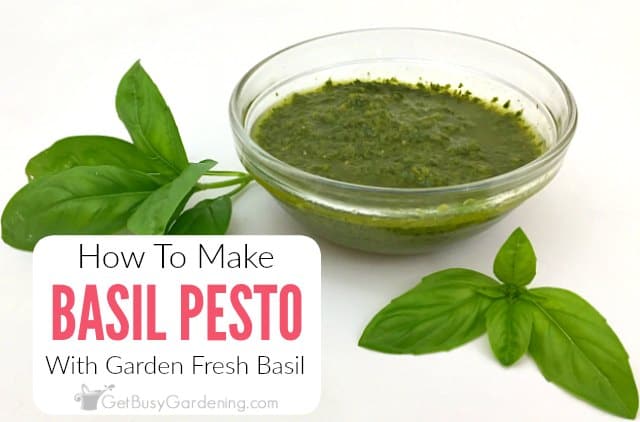
I love garden fresh basil, it’s such a wonderful treat during the summer and I grow it in my garden every year.
I also love making pesto to freeze for winter use. I don’t like the taste of pine nuts, and so many traditional pesto recipes have nuts and cheese in them.
So, I decided to create my own, quick and easy basil pesto recipe without nuts and cheese. That way I can whip up a batch whenever it’s ready in the garden.
You can use my recipe for making pesto whether you grow it in your garden, or buy it from the store.
This basic pesto recipe has only four ingredients, and is super easy to make. Before I show you how to make basil pesto, we’ll talk about the best types to use, and how to prepare it.
The Best Basil For Pesto
The main ingredient of pesto is basil, and there are lots of different varieties to choose from. Traditional basil pesto is made using a sweet variety, like Genovese or Italian.
But you can also use other varieties, like purple, lemon or Thai for this recipe if that’s what you have growing in your garden.
Heck, you could even try mixing the different varieties if you want to experiment with flavor combos.
Just keep in mind that each of these varieties has a different flavor, so they will definitely change the flavor of your basil pesto.
It’s fun to experiment, but if you want to make a classic basil pesto, then stick to using a sweet variety.
Making Pesto With Fresh Basil From The Garden
If you’re planning on using it from your garden, it’s important to know how to harvest it so that it’s as fresh as possible.
So below I’ll share a few tips for how to prepare basil for pesto. If you bought it from the store, then you can skip this next section.
Related Post: How To Grow Basil From Seed
How To Prepare Basil For Pesto
One of the best things about growing your own is that you can run out to the garden any time you want, and pinch off the exact amount of leaves you need to make your own pesto.
But, if I have a large amount of that I plan to pull all at once, I’ll grab a bucket of water before heading out to the garden.
Then I will cut each plant off at the base, and put the stems into the water. Otherwise it will droop very quickly.
That way I can take my time gathering and preparing all of my basil before making pesto. If you do this, just be sure the leaves aren’t soaking in water too long, or they can start to turn brown.
How To Clean Basil Leaves
Only choose the healthiest leaves to use for making basil pesto, and toss out any that are yellow or brown.
After they’re removed from the stem, rinse them several times to wash off any bugs or dirt. Don’t allow them to soak in water though, and be sure to dry them right away so they don’t turn brown.
The best tool to use for this is a salad spinner (best invention ever!), but you can use a towel to gently pat them dry if you prefer. Now I get to show you how to make basil pesto!
My Easy Homemade Basil Pesto Recipe
Once the leaves are no longer wet, it’s time to make some homemade pesto! I like to use this basic recipe to freeze for winter use.
That way I have a nice base to start with. I can eat it as is, or add whatever I want when I use it for my recipes. This simple pesto recipe yields about 1/2 cup.
Supplies Needed
- Food processor
- Measuring cups
- Knife
- Bowl
- Zester (or fine grater)
- Spatula scraper
- Garlic peeler (optional)
Basil Pesto Ingredients
- 2 cups loosely packed fresh basil leaves, cleaned and dried
- 2-4 garlic cloves
- 1/2 fresh lemon, zest and juice
- 1/4 cup extra virgin olive oil
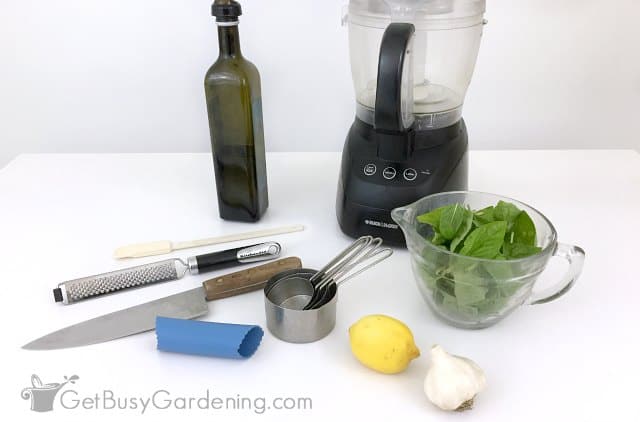
How To Make Basil Pesto
Step 1: Prepare the garlic – Peel the garlic cloves by hand or use a garlic peeler, and then crush the cloves using the side of your knife. Set them aside.
Step 2: Chop the leaves – Put all of the leaves into your food processor and pulse it several times to chop them up.
Pulsing the leaves before adding other ingredients helps keep the consistency even. The leaves tend to stick to the side of the food processor, so use your spatula scraper as necessary to push them back down to the bottom.
Step 3: Add the garlic – Drop all of the crushed garlic cloves into the food processor, and pulse it again several times to mix it in well.
Step 4: Slowly add the olive oil – Open the feed chute on your food processor and slowly drizzle the olive oil in as you continue pulsing.
You can stop once in a while to open the top and scrape the sides to ensure all of the ingredients are being evenly mixed together, if necessary.
Step 5: Add the lemon juice and zest – Pour the contents of the food processor into a bowl, then use your zester to zest the 1/2 lemon into the bowl. Then squeeze the lemon juice over the top. Stir everything together well.
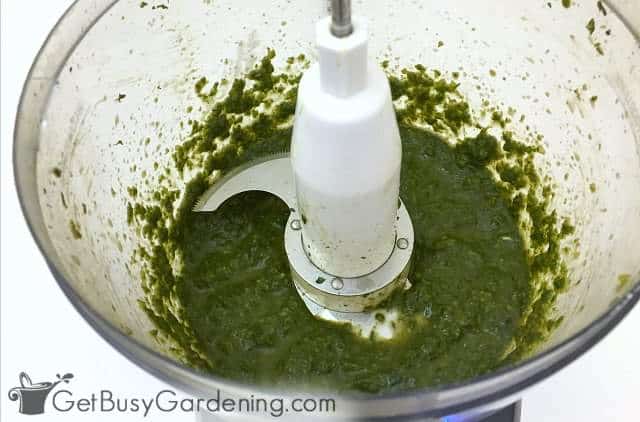
Tips For Storing Basil Pesto
You can use your homemade basil pesto right away, or store it for later use. If you plan to use it within a few days, then just store it in the fridge.
Otherwise, it’s best to freeze it to keep it fresh, rather than risk leaving it in the refrigerator for too long.
Related Post: How To Preserve & Store Basil (Leaves Or Stems)
How To Freeze Basil Pesto
Freezing basil pesto is easy, and a great way to preserve it for winter use! The best part is that it thaws quickly, and tastes just as good as it did when you first made it.
The best way to do it is to use ice cube trays. Once they’re solid you can just pop the pesto cubes into a freezer bag for long term storage.
I use a mini ice cube tray that holds one tablespoon portions, which is the perfect amount for quick use in many recipes.
FAQs
In this section, I’ll answer some of the most frequently asked questions about making basil pesto. If you can’t find your answer here, ask it in the comments section below.
Can you add water to basil pesto?
I do not recommend adding water to this basil pesto recipe. Since oil and water don’t mix, it will only ruin the texture and weaken the flavor.
I have heard of people adding a tiny bit of pasta water to theirs, but I’ve never tried doing that myself. If your pesto is too thick, then it’s best to add a bit more oil to thin it out, rather than trying to add water.
This is the best basil pesto recipe for beginners! It’s delicious, and making it without pine nuts and cheese is definitely healthier for you too. Now that you know how to make basil pesto, you can whip up a batch straight from the garden any time you want.
More Garden Fresh Recipes
- Healthy Veggie Dip Recipe
- Sun Dried Cherry Tomatoes: An Easy Homemade Recipe
- How To Make Homemade DIY Liquid Stevia Extract
- How To Make Bee Balm Tea From Your Garden
- Quick & Easy Zucchini Relish Recipe
- How To Make Rhubarb Jam: Easy Recipe
Share your tips for how to make basil pesto, or your favorite recipe, in the comments below.
Print This Easy Recipe!
Easy Basil Pesto Recipe
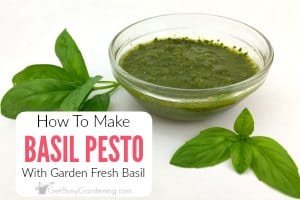
If you’re looking for a simple and quick basil pesto recipe, then you’re in luck! Not only is this 4 ingredient recipe is fast and easy, it's gluten-free, nut-free, and dairy free!
Ingredients
- 2 cups loosely packed fresh basil leaves, cleaned and dried
- 2-4 garlic cloves
- 1/2 fresh lemon, zest and juice
- 1/4 cup extra virgin olive oil
Instructions
- Prepare the garlic – Peel the garlic cloves by hand or use a garlic peeler, and then crush the cloves using the side of your knife. Set them aside.
- Chop the basil leaves – Put all of the basil leaves into your food processor and pulse it several times to chop them up. Pulsing the leaves before adding other ingredients helps keep the consistency even. The leaves tend to stick to the side of the food processor, so use your spatula scraper as necessary to push them back down to the bottom.
- Add the garlic – Drop all of the crushed garlic cloves into the food processor and pulse it again several times to mix it in with the basil leaves.
- Slowly add the olive oil – Open the feed chute on your food processor and slowly drizzle the olive oil in as you continue pulsing. You can stop once in a while to open the top and scrape the sides to ensure all of the ingredients are being evenly mixed together, if necessary.
- Add the lemon juice and zest – Pour the contents of the food processor into a bowl, then use your zester to zest the 1/2 lemon into the bowl. Then squeeze the lemon juice over the top. Stir everything together well.
Notes
You can use your homemade basil pesto right away, or you can store it for later. If you plan to use it within a few days, then just keep it in the fridge.
Otherwise, it’s best to freeze it to keep it fresh, rather than risk leaving it in the refrigerator for too long.

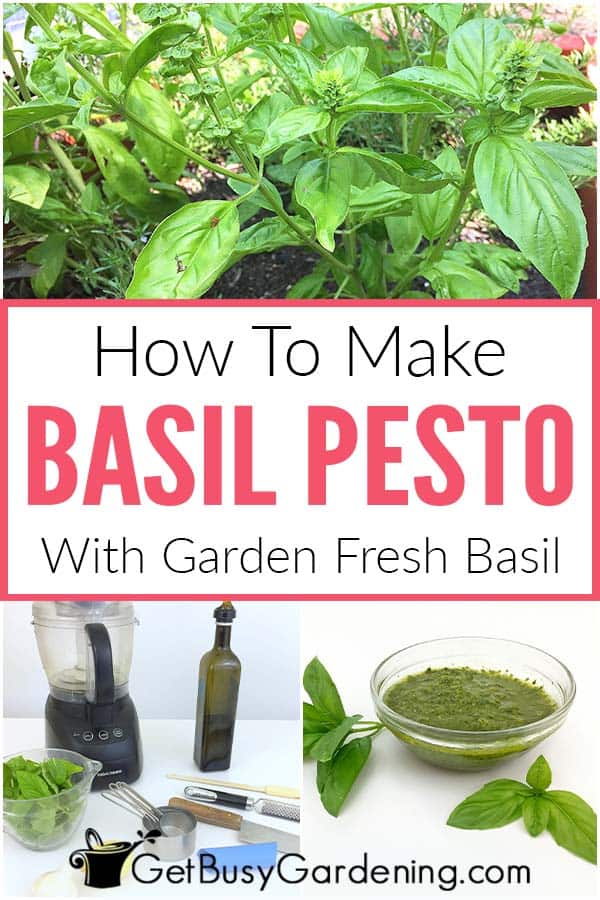
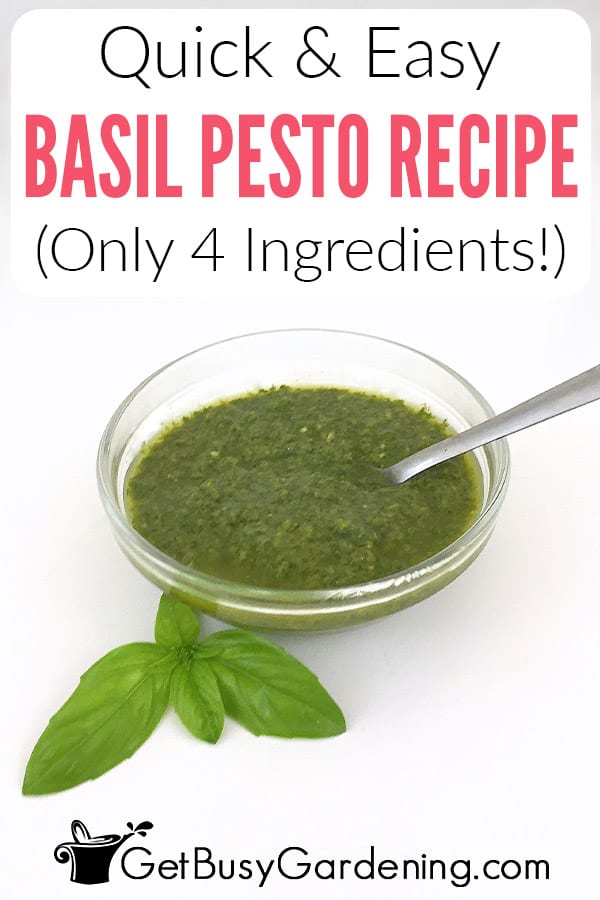
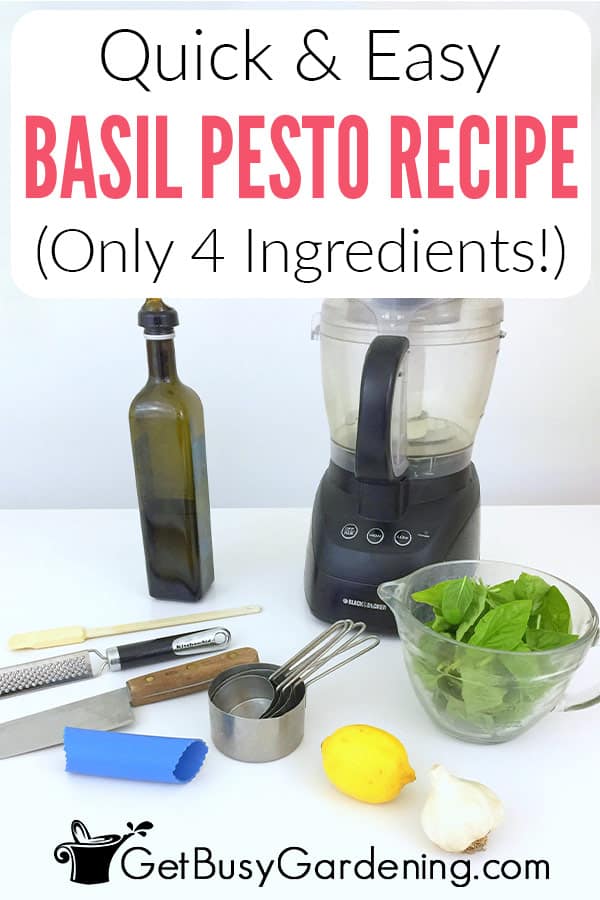

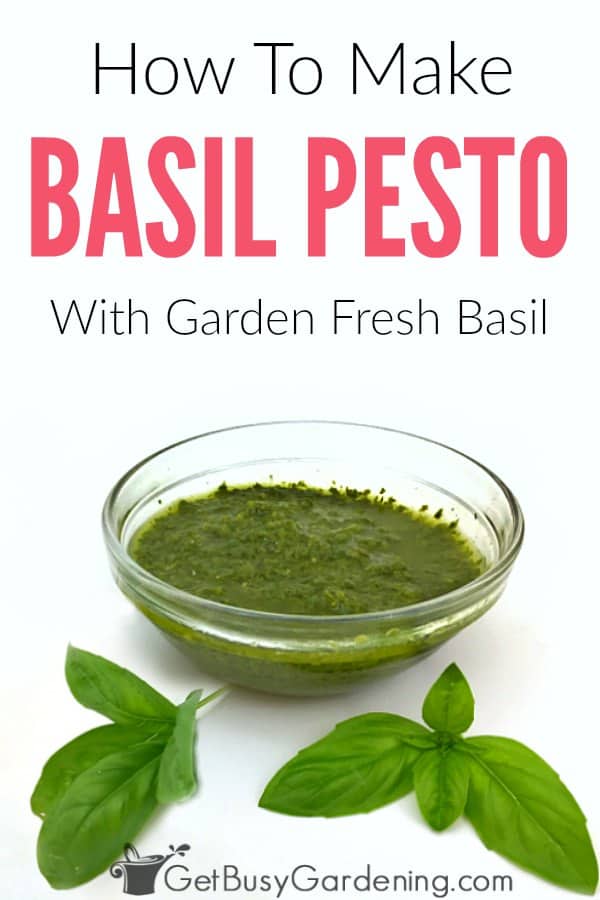

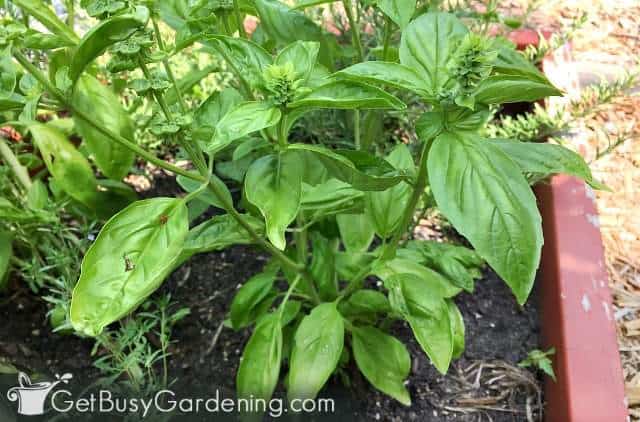
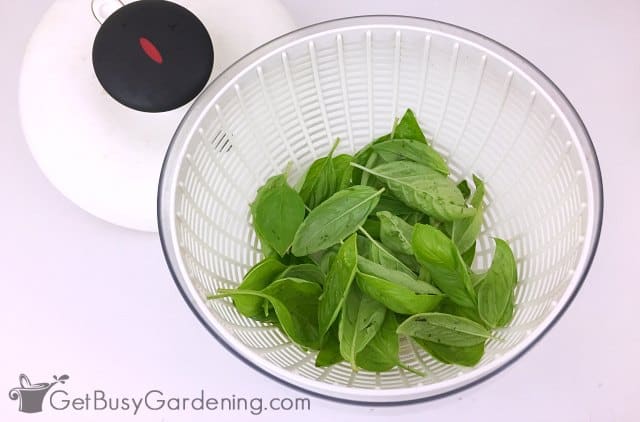
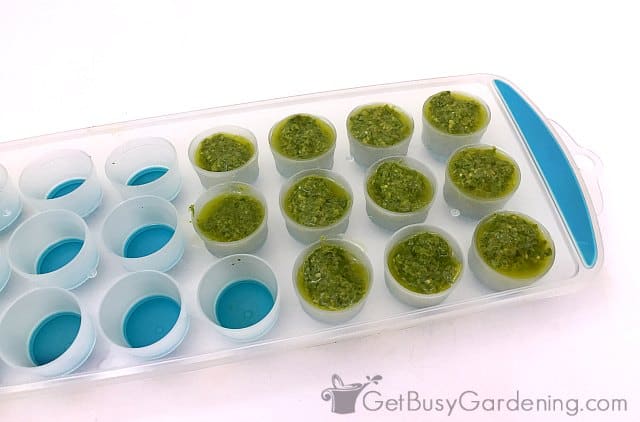

Mel Purdy says
My pesto lost its bright green color during processing what happened?
Amy Andrychowicz says
Yes, it’s very common for pesto to turn brown – and frustrating! I’ve never had that happen with my recipe before, so make sure you’re using enough lemon juice, or you could try adding more next time. The browning is caused by oxidation (i.e.: exposure to the air), so also make sure you don’t over-process your pesto. Then cover and refrigerate it right away once it’s ready. You can also try pouring a tiny bit of olive oil over the top of the pesto before storing it to help keep the air out and slow browning.
Pam says
Mine is bitter. What did I do wrong? I used organic basil, organic garlic, organic Myers lemon and organic olive oil
Amy Andrychowicz says
Pesto can taste bitter for a few reasons, mainly over processing the ingredients (only blend them until all the large pieces are gone), using bitter olive oil (some types are naturally more bitter than others so taste it, or the oil may be past it’s date and rancid), or using basil from a plant that has bolted (when a basil plant flowers, the leaves will become more bitter). To offset the bitterness in your pesto you could try adding a little bit of sugar or honey, or something acidic, like vinegar or citrus juice.
Sandy says
I’m growing basil, love the scent, but don’t know how to use it. I’ve never made pesto either, not sure what to do with it? Any ideas would be greatly appreciated! Thank you!
Amy Andrychowicz says
You should definitely try making basil pesto then! It is super yummy, and you can use it in anything (on eggs or toast, making pasta, or really any Italian dish). It also freezes very well, so you can enjoy it all winter long. You could also try drying your extra basil it to fill your spice rack… How To Dry Herbs From Your Garden
Amy Andrychowicz says
@FranksGreenGirl – I totally dreaded it too!! I've been so busy lately with other harvesting and preserving that I was thinking about letting the basil go. But last weekend, I thought… well this is a task I only do once a year, and I'll be sad not to have pesto in the freezer this winter… so I harvested the basil and got the pesto done! 🙂 I wish I had a little helper like you, cute!
FranksGreenGirl says
There are not that many herbs in the garden quite as tasty as fresh basil or basil that's been made into pesto. A little part of me dreaded the basil harvest last week when I made pesto because of all the separating the leaves from the stalks and washing and drying. However, I have a little helper who did the stripping and washing and I did the processing into pesto.